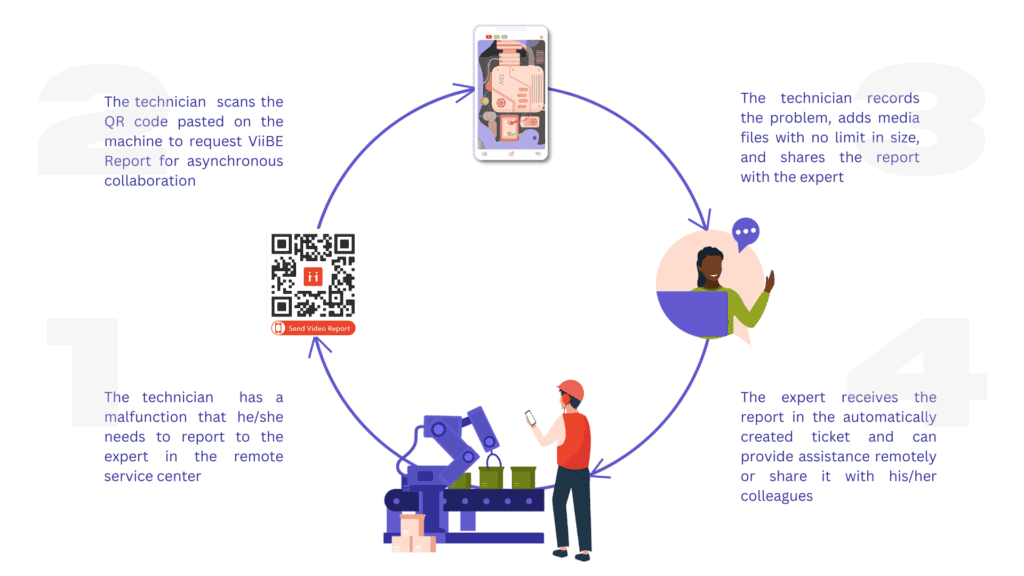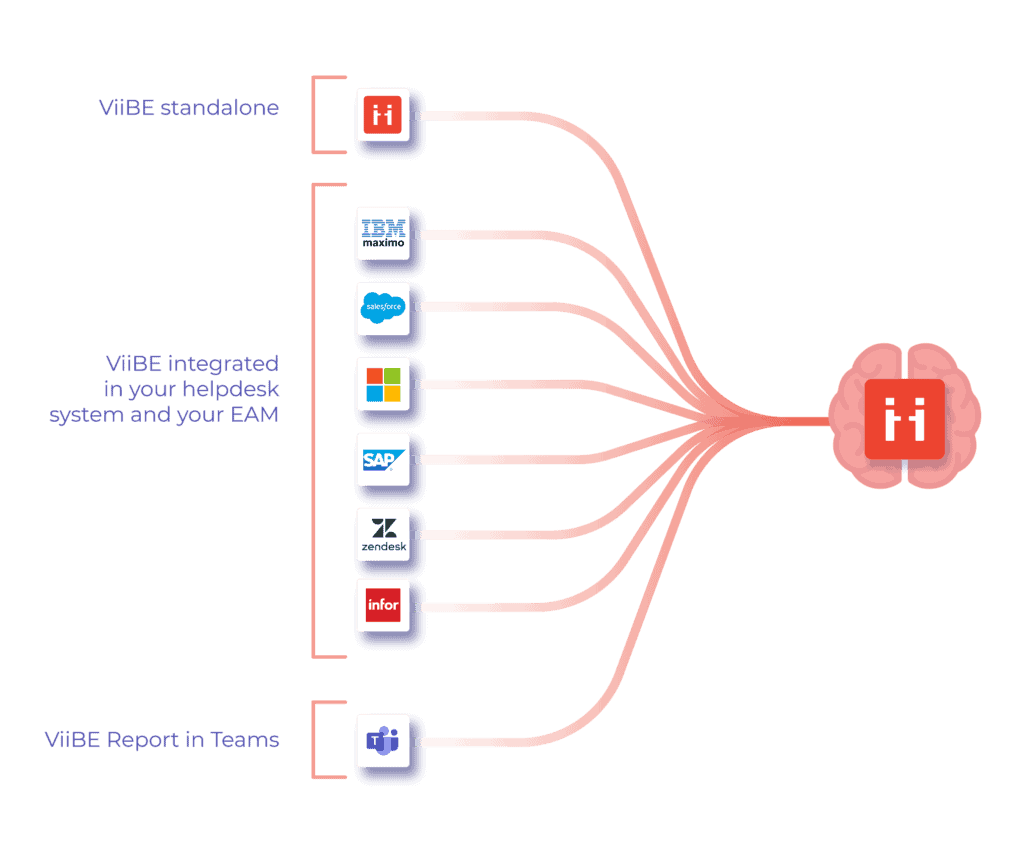In recent years, digitalization has forever changed the way businesses operate. Following the skyrocketed demand for technologies that would allow companies to perform their operations remotely, video assistance tools have won the place under the sun. In such a complex domain as Field Service Management (FSM), video assistance solutions are starting to play a crucial role: thanks to them, experts in the service centers become the eyes and ears of the technicians on-site and help the latter to perform intervention activities in the most effective way.
What trends in video assistance are here to stay and continue to influence FSM? What advantages do they bring to FSM?
1. Visual assistance
Sometimes the encountered problem is too complex for a technician to explain to an expert using traditional channels of communication (phone, email, etc). The back-and-forth exchanges are time-consuming, and both parties are limited by the data cap constraints when they cannot share large media attachments. It is difficult to track data, and there is a risk of losing them. Video assistance tools overcome this difficulty. When the expert joins the session, he/she benefits from a 360° view of what the technician sees and hears without unnecessary displacement. Video assistance becomes a bridge between the service center and the site.
A variety of collaborative tools makes it possible to capture HD images (which is a really useful feature on-site with degraded connectivity) and annotate them in order to not only spot the actual cause of the problem but also guide the technician through the resolution of it. The annotations are saved after the session for the collaborators to consult at any time. The information can be converted into tutorials, guides, and other forms of learning materials for future use.
As a result, video assistance brings several advantages to FSM:
- Interventions can be conducted remotely which saves transportation costs that could have been spent on unnecessary displacement.
- The maintenance process gets significantly sped up because it takes a couple of minutes for a technician to send an SMS link to an expert with the invitation to join the video call right from his/her interface of the FSM solution that he/she uses.
- Technicians make well-informed decisions as they are able to troubleshoot and get connected with experts in service centers in one click. It boosts employee confidence and the level of autonomy.
2. Asynchronous collaboration
The availability of technicians on the clock can be a complicated requirement to fulfill when there is a big number of interventions or if a company operates in different geographical locations, so time and language constraints join forces to sabotage efficiency. What should an expert do when a technician reports the problem, but once he/she is available to provide assistance, the technician is no longer in front of the malfunction?
For a while, video assistance solutions provided only real-time collaboration, but as the market voiced the need for asynchronous collaboration, video assistance tools have been enhanced with this new functionality and the new trend emerged.
It shares the same principle as a real-time call, except for the fact that the technician enters a unilateral video stream to capture all the details about the encountered problem, add supporting documents, and send it to the expert. The latter can access the shared information inside the intervention on the FSM platform. Upon availability, the expert can consult the files and provide assistance by either triggering a real-life call or enriching the intervention with new files. There is no data cap, therefore this functionality serves as a substitute for e-mail attachments and file-sharing software that allows unlimited data sharing and storage only with paid subscription plans.
A report created asynchronously also serves as proof of conducted intervention which is crucial for the SLA requirements that companies need to respect.
All the shared data is stored inside the intervention and, therefore, can be tracked.

3. Knowledge management capabilities
Knowledge management is the practice the company adopts in order to become more productive. Among its methods, the crucial aspects of it concern the way data is stored, retrieved, shared, and evaluated. When it comes to field service management software, it is important that it is interoperable with EAM, CRM, and ERP tools since companies that perform interventions use a variety of them to enrich interventions with additional information about the problem. This allows technicians to get a full view of the needed assistance.
When video assistance technology is seamlessly integrated with an FSM solution, it creates a synergy between the two. Neither of the collaborators has to change their user habits, as all the data generated during the video support session automatically feeds data into the FSM tool.
By naturally following the evolution of video assistance trends, some of the most advanced video assistance solutions have developed the capabilities to be a ticketing system on their own. The WebSDK connector allows them to be integrated with any FSM, CRM, CMMS, etc.
Data generated during the video call can be used for multiple purposes: educational materials for technicians, as the base for customer testimonials, and it can also be shared with R&D departments for product improvements.

4. Interoperability: the importance of seamless integration
The interoperability trend is not a video assistance trend per se but rather the main pillar that companies in general have to rely on if they want to be a part of the new era: the platform economy. The hierarchical state is now long forgotten and every digital solution can become a part of the global supply chain.
The key to becoming an efficient and in-demand tool is to be highly agile and integrated with other market players. For example, some companies have developed their own ERPs, so for FSM solutions it becomes extremely crucial to have the capacity to develop a customized connector in order to be integrated with it.
As it has become clear in the aforementioned paragraphs, video assistance can deliver great value to FSM tools. Hence, FSM solutions should look for integration with those video assistance tools that are compatible with most of the market actors. This is a great incentive for video assistance solutions to develop their connectors because if they are not fulfilling this need, they risk losing exposure to a sufficient number of customers.
With data exchange comes an increased need for data protection, and this is why advanced video assistance solutions invest heavily in security measures to minimize the possibility of a data breach.
5. Adoption of cloud-based tools instead of on-premise software
On-premise software is hosted locally and runs solely on a company’s hardware infrastructure. In contrast, cloud software is stored and managed on the provider’s service. It can be accessed either through a web browser or other interface. Just from this short description, the main drawback of on-premise software becomes evident: it is not flexible and too cumbersome to manage. In the age of digitalization, companies cannot afford to adapt to the changes slowly.
Video assistance tools are mostly cloud-based. The maintenance cost is not expensive, and there are numerous advantages regarding data management. Collaborators can easily share data that is backed up and can always be restored. Cloud computing provides a significant benefit in terms of safeguarding data, as it presents various cutting-edge security functionalities that guarantee the secure storage and management of data.
FSM solutions that aim to become best-of-breed have already recognized that the applications market inclines towards cloud computing. They make it their priority to adjust to different use cases and give the companies flexibility and easy implementation of FSM tools.
Cloud computing has also simplified integrations in the best traditions of the platform economy.
ViiBE, a cloud-based video assistance provider, is a part of Praxedo’s product offering.
Praxedo is also cloud-based; it is a Field Service Management software solution that empowers service companies to organize their processes and increase customer satisfaction levels. By enriching Praxedo’s product suite, ViiBE allows Praxedo’s customers to boost one of the most important metrics in FSM – the first-call fix rate.

